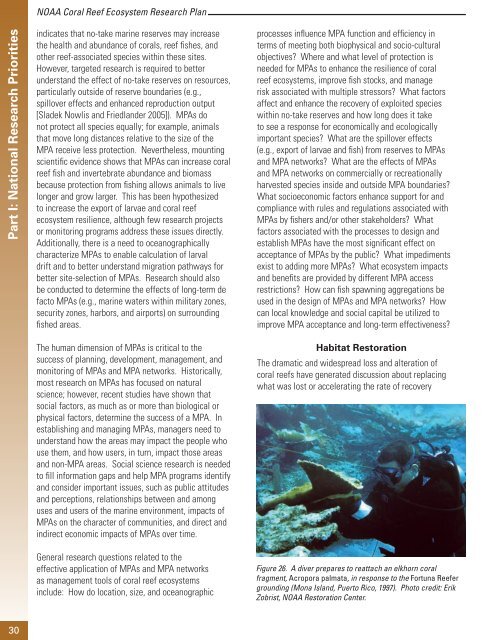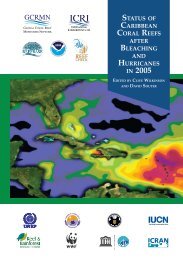noaa coral reef ecosystem research plan - Mississippi-Alabama Sea ...
noaa coral reef ecosystem research plan - Mississippi-Alabama Sea ...
noaa coral reef ecosystem research plan - Mississippi-Alabama Sea ...
Create successful ePaper yourself
Turn your PDF publications into a flip-book with our unique Google optimized e-Paper software.
NOAA Coral Reef Ecosystem Research Plan<br />
Part I: National Research Priorities<br />
indicates that no-take marine reserves may increase<br />
the health and abundance of <strong>coral</strong>s, <strong>reef</strong> fishes, and<br />
other <strong>reef</strong>-associated species within these sites.<br />
However, targeted <strong>research</strong> is required to better<br />
understand the effect of no-take reserves on resources,<br />
particularly outside of reserve boundaries (e.g.,<br />
spillover effects and enhanced reproduction output<br />
[Sladek Nowlis and Friedlander 2005]). MPAs do<br />
not protect all species equally; for example, animals<br />
that move long distances relative to the size of the<br />
MPA receive less protection. Nevertheless, mounting<br />
scientific evidence shows that MPAs can increase <strong>coral</strong><br />
<strong>reef</strong> fish and invertebrate abundance and biomass<br />
because protection from fishing allows animals to live<br />
longer and grow larger. This has been hypothesized<br />
to increase the export of larvae and <strong>coral</strong> <strong>reef</strong><br />
<strong>ecosystem</strong> resilience, although few <strong>research</strong> projects<br />
or monitoring programs address these issues directly.<br />
Additionally, there is a need to oceanographically<br />
characterize MPAs to enable calculation of larval<br />
drift and to better understand migration pathways for<br />
better site-selection of MPAs. Research should also<br />
be conducted to determine the effects of long-term de<br />
facto MPAs (e.g., marine waters within military zones,<br />
security zones, harbors, and airports) on surrounding<br />
fished areas.<br />
processes influence MPA function and efficiency in<br />
terms of meeting both biophysical and socio-cultural<br />
objectives? Where and what level of protection is<br />
needed for MPAs to enhance the resilience of <strong>coral</strong><br />
<strong>reef</strong> <strong>ecosystem</strong>s, improve fish stocks, and manage<br />
risk associated with multiple stressors? What factors<br />
affect and enhance the recovery of exploited species<br />
within no-take reserves and how long does it take<br />
to see a response for economically and ecologically<br />
important species? What are the spillover effects<br />
(e.g., export of larvae and fish) from reserves to MPAs<br />
and MPA networks? What are the effects of MPAs<br />
and MPA networks on commercially or recreationally<br />
harvested species inside and outside MPA boundaries?<br />
What socioeconomic factors enhance support for and<br />
compliance with rules and regulations associated with<br />
MPAs by fishers and/or other stakeholders? What<br />
factors associated with the processes to design and<br />
establish MPAs have the most significant effect on<br />
acceptance of MPAs by the public? What impediments<br />
exist to adding more MPAs? What <strong>ecosystem</strong> impacts<br />
and benefits are provided by different MPA access<br />
restrictions? How can fish spawning aggregations be<br />
used in the design of MPAs and MPA networks? How<br />
can local knowledge and social capital be utilized to<br />
improve MPA acceptance and long-term effectiveness?<br />
The human dimension of MPAs is critical to the<br />
success of <strong>plan</strong>ning, development, management, and<br />
monitoring of MPAs and MPA networks. Historically,<br />
most <strong>research</strong> on MPAs has focused on natural<br />
science; however, recent studies have shown that<br />
social factors, as much as or more than biological or<br />
physical factors, determine the success of a MPA. In<br />
establishing and managing MPAs, managers need to<br />
understand how the areas may impact the people who<br />
use them, and how users, in turn, impact those areas<br />
and non-MPA areas. Social science <strong>research</strong> is needed<br />
to fill information gaps and help MPA programs identify<br />
and consider important issues, such as public attitudes<br />
and perceptions, relationships between and among<br />
uses and users of the marine environment, impacts of<br />
MPAs on the character of communities, and direct and<br />
indirect economic impacts of MPAs over time.<br />
General <strong>research</strong> questions related to the<br />
effective application of MPAs and MPA networks<br />
as management tools of <strong>coral</strong> <strong>reef</strong> <strong>ecosystem</strong>s<br />
include: How do location, size, and oceanographic<br />
Habitat Restoration<br />
The dramatic and widespread loss and alteration of<br />
<strong>coral</strong> <strong>reef</strong>s have generated discussion about replacing<br />
what was lost or accelerating the rate of recovery<br />
Figure 26. A diver prepares to reattach an elkhorn <strong>coral</strong><br />
fragment, Acropora palmata, in response to the Fortuna Reefer<br />
grounding (Mona Island, Puerto Rico, 1997). Photo credit: Erik<br />
Zobrist, NOAA Restoration Center.<br />
30

















